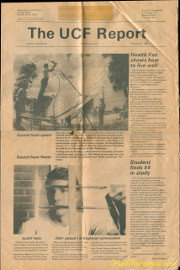Plasma Speaker
The engineering fair at UCF was a popular way for all disciplines within the college of engineering to highlight their capabilities in the way of technology demonstrations, project competitions, etc. I decided to enter a project in the fair. The project I decided upon was based on an old article I read in Popular Electronics magazine about modulating a plasma to produce sound waves.
The basic concept of the plasma speaker derived from earlier technologies including flame photophones and speaking arcs.
A flame photophone is an optical communication device using a mechanically modulated gas flame to transmit voice information wirelessly to a photocell connected to a speaker.
Speaking arcs are another group of communication devices using an electrical arc as a speaker and/or optical transmitter. The modulated arc can produce sound locally via the arc, or wirelessly to a distant receiver comprising a photocell connected to a conventional speaker.
I was able to borrow a 400vdc Lambda power supply from the physics department and an acetylene torch from the college of engineering's machine shop. For an audio mixer, I needed a large transformer which I was able to find after a few scrounging trips to Skycraft in Winter Park. For the electrodes I used copper clad carbon arc gouge rods. For audience protection, I obtained dark plexiglass sheets and built a protective screen to prevent viewers from getting too close or injuring their eyes staring at the flame. I probably scrounged up the remainder of the components at Skycraft in Winter Park.
My roommate helped me set everything up in the lab. What I did was to mix audio from a stereo onto a high voltage DC carrier. The output went to a pair of high temperature electrodes inserted into an acetylene flame. As material from the electrodes slowly melted away, a charged plasma formed between the two electrodes. Because the plasma had some density, it's modulation created sound waves.
Using a frequency generator and oscilloscope we measured the range but I forget what it was. As a tweeter, the plasma speaker's performace across the upper audio range was outstanding. The response was very flat across frequencies suitable for a tweeter. The low density of the plasma didn't reproduce the bass or mid range very well but the lower frequencies were there, the plasma just couldn't move enough air to faithfully reproduce them audibly.
Once I decided I was pretty confident with the setup, I brought the professor I worked for into the lab for a demo. After looking at it, he said he wanted the dean to see it and left the lab. A short while later, he returned to the lab with the dean and several other professors at which point I demo'ed it again.
On the day of the fair, the plasma speaker was quite an attention getter. I planned to play The William Tell Oveture repeatedly but soon grew tired of listening to the same thing and switched to a local radio station. Several local television stations aired clips that evening of the plasma speaker and I won first place in the individual project category.





